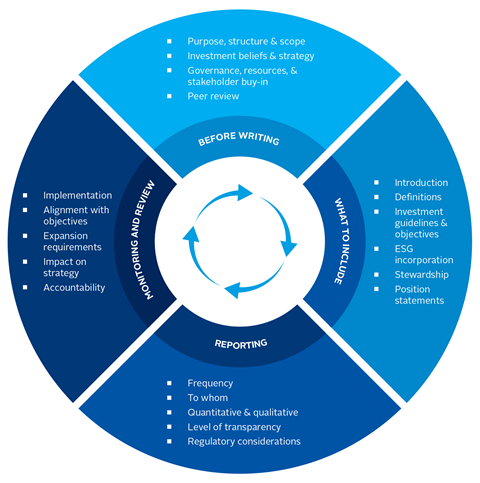A technical guide for asset owners and investment managers.
Executive summary
A responsible investment policy guides an organisation on asset allocation, investment decisions, how stewardship is carried out and how it reports on its activities, ensuring consistency and longevity.
It allows investors to outline what they do and why they do it – for example, how they view environmental, social and governance (ESG) risks and opportunities and system-level sustainability issues or how they interpret their fiduciary duties in relation to ESG incorporation or active ownership.
Client and beneficiary demand has grown, regulation has developed and there is an increasing understanding of the financial materiality of ESG issues, and a focus on real-world outcomes. These factors have all contributed to responsible investment practices evolving rapidly in recent years, moving firmly from niche to mainstream.
As a result, investment managers’ and asset owners’ policies have also progressed and are being updated to reflect new practices and areas of focus. These documents have developed from simple statements to sophisticated multi-page documents and websites with a wealth of detail.
This guide aims to highlight what investors should consider before writing or updating a policy, what they could include and what reporting, monitoring and reviewing a policy might look like in practice.
It draws on previously published guidance, the Reporting Framework and associated minimum requirements of being a PRI signatory, and where relevant, highlights examples of leading practice that readers can use to inform their own documents.
Developing and updating a responsible investment policy

Considerations before writing
Before developing (or updating) a responsible investment policy, asset owners and investment managers should consider:
- the purpose and audience it will serve;
- its structure and scope;
- relevant sustainable finance regulations;
- how it will fit with – and reflect – their fiduciary duties, investment strategies and beliefs; and
- the resources and stakeholder buy-in needed to write, approve, and implement it.
Organisations should also identify if they already have policies on certain operational issues, such as stock lending or conflicts of interest, and how these will exist alongside a responsible investment policy or be incorporated into (and replaced by) the latter.
As investors increasingly recognise that long-term financial returns largely depend on the viability of environmental and social systems, they should consider system-level undiversifiable sustainability issues such as human rights and climate change.
Investors should then consider how – in line with their fiduciary duties – their investment and stewardship activities can address these systemic risks by developing mitigation strategies using their levers of influence, ensuring their investment beliefs, strategy and policy documents overall reflect the approach they take. Finally, undertaking a peer review can help align with leading practice.
What to include
There are many components that asset owners and investment managers can choose to include in their investment policies, and these will vary in detail depending on their level of responsible investment experience, mandates, and whether the policy is an all-encompassing document or something that complements other policies and statements.
An introduction can provide context around how a policy was developed, its governance, purpose, scope and the beliefs, objectives, and stakeholder, client, or beneficiary needs that underpin it. It can also set out an organisation’s positions on core ESG issues, such as human rights and climate change, how issues interact with each other, and how the organisation wants to contribute to creating a sustainable financial system.
A section on investment guidelines and objectives can be used to explain broadly how an organisation will incorporate ESG considerations within its investment processes, including any specific targets it has and what it needs to do to achieve them.
Investors may choose to outline their ESG incorporation approach(es), such as screening, ESG integration or thematic investing, in more detail.
Investors should also cover how they approach stewardship in their responsible investment policy, including how this contributes to their responsible investment objectives and beliefs, and any sustainability outcomes that they are pursuing. Some organisations choose to have a standalone document covering stewardship, or specific stewardship activities such as engagement.
Reporting
Signatories to the PRI are expected to report on their activities and progress towards meeting the Principles annually, while providing transparency to clients and/or beneficiaries is considered industry best practice.
As such, asset owners and investment managers can highlight their reporting practices in their responsible investment policies. Doing so can help ensure that they are held accountable for implementing their responsible investment policies.
Monitoring and review
All aspects of an organisation’s responsible investment policy need to be monitored periodically to evaluate success and identify underperforming areas. Organisations should review their policies annually, and where updates are needed, they should re-review the What to consider before writing a responsible investment policy section, particularly around governance, which considers implementation.
Download the full report below.
CREDITS | Author: Tom Attwooll, Senior Specialist, Asset owners | Contributors: Toby Belsom, Eilidh Wagstaff, Michal Bartek, Kelly Krauter, Emmet McNamee, Irene Diaz, Sylvaine Rols | Editor: Jasmin Leitner | Design: Will Stewart
Downloads
Developing and updating a responsible investment policy technical guide
PDF, Size 10.1 mbÉlaboration et mise à jour d'une politique d'investissement responsable (French)
PDF, Size 5.28 mbDeveloping and updating a responsible investment policy (Chinese) 制定和更新负责任投资政策
PDF, Size 1.71 mbFormulación y actualización de una política de inversión responsable (Spanish)
PDF, Size 1.81 mb












